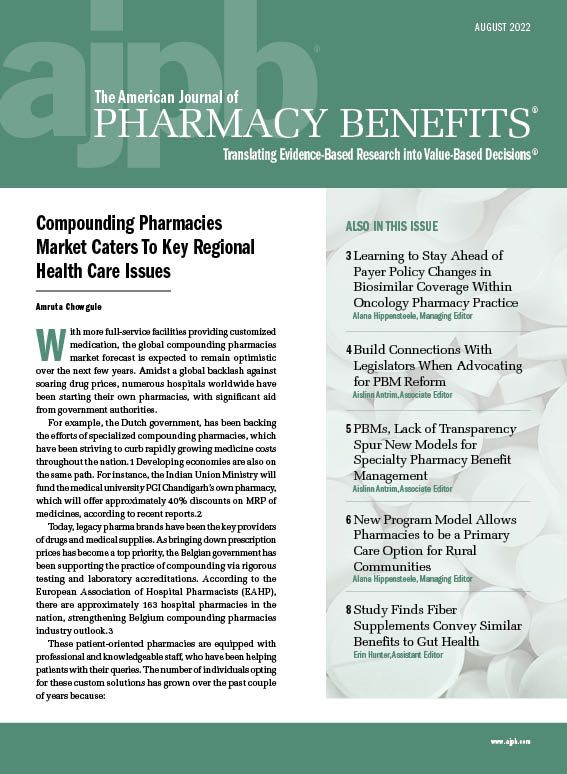Publication
Article
AJPB® Translating Evidence-Based Research Into Value-Based Decisions®
Learning to Stay Ahead of Payer Policy Changes in Biosimilar Coverage Within Oncology Pharmacy Practice
Author(s):
With the rapid pace of change in biosimilar payer benefit design, efforts to stay regularly updated on policy changes ahead of time become critical for patient care.
There has been a significant gain in clinical confidence in the demonstration process for biosimilars, explained discussion panel moderator Jorge García, PharmD, MS, MHA, MBA, FACHE, during a session at the 2022 ATOPP Summit. However, the challenge remains learning how to overcome and manage the different roadblocks and opportunities that the evolution of biosimilars continues to present to oncology pharmacy practices.
“One of the biggest challenges that we face is really preparing and staying ahead of payer benefit design and changes that come our way throughout the year— sometimes on a quarterly basis,” García said.
In light of this rapid pace for the evolution of biosimilars in terms of payer benefit design, García noted that it becomes critical to find a method of staying ahead of policy changes that can ultimately impact operations down the line.
Panel participant Mandy C. Leonard, PharmD, BCPS, the system director of drug use policy and formulary management at Cleveland Clinic, noted that at her institution, due to the everchanging nature of biosimilar payer benefit design, pharmacists at her organization have had to learn how to adapt to these frequent changes by monitoring what's going on at the Cleveland Clinic, not only from an inventory perspective, but from a formulary management perspective.
“I think we'd all like to say that if we could select one biosimilar to a reference product in our organization, that would be the best for us as far as controlling a lot of aspects of it, but that's not always the case,” Leonard said. “So I think some of the challenging things over the past several years after the introduction to some of the biosimilars is how do you manage all of that, and I think one of the biggest lessons that I learned is that I thought we were doing such a fantastic job of streamlining biosimilars within our organization once we had buy in from the medical staff, but then I learned that that may be impacting patient care, because [of issues] on the other side of things with insurance.”
Additionally, pharmacists may not always know when there's going to be a payer coverage change. Leonard noted that in light of this, it’s important to work with a strong team within the institution who can help to ensure that the pharmacist remains aware of those coverage changes. Whether that team is within billing, marketing, or network strategy department, they can help pharmacists assess ahead of time what they are going to do about coverage changes within the electronic health record (EHR) in order to help providers on their end of things.
Panel participant Kenneth Komorny, PharmD, BCPS, the chief pharmacy officer at the Moffitt Cancer Center, noted that at his institution, they’ve embraced the managed care department for the purposes of effective collaboration on this front at the Moffitt Cancer Center and meet with them on a quarterly basis to ensure a strong level of communication regarding changes in biosimilar payer coverage.
“We've tried to be proactive, having them comb through the payer policy changes to make sure that we're on top of that. Otherwise, you get surprised,” Komorny said. “So they maintain a spreadsheet for us, and we try to capture the majority of them. They have hyperlinks within it; it's a living document, and we’re able to click in and find out in real time what the insurance policy is around [a biosimilar].”
With the living document noting payer policy changes in real time, Komorny noted that pharmacists at the Moffitt Cancer Center can make a one-page guide for pharmacy staff to ensure everyone stays informed regarding which drugs are available. Additionally, the pharmacists note the major payers in the system as well as the different products, and whether they are they covered or not covered by the insurance company, and whether they are formulary or non-formulary.
“It works as a guide for the pharmacy staff to know which drugs we have available and which ones we don't. But again, it's really reaching out to your managed care department and your payer strategies department and working with them to create this [spreadsheet]. We don't have the expertise to be able to comb through these insurance policies—they are very, very long,” Komorny said. “So we kind of lean on them to do that part, and then we boil it down from the pharmacy perspective.”
Komorny noted that even with this living document noting payer policy changes that impact the pharmacist’s practice, it also remains important to run benefits investigations for every patient and every date of service because policies can change from quarter to quarter.
“In fact, that's what we see in practice,” Komorny said. “We also have patients change jobs in Florida, we have temporary Medicaid, where patients may have insurance in one month but not in the other. So it's a lot of work to stay ahead of the policies and then run that benefits investigation every time.”
REFERENCE
García J, Leonard MC, Komorny K, Rozenblyum E. Real-World Impact of Biosimilars on Healthcare Costs. San Diego, CA: 2022 ATOPP Summit; July 16, 2022.


Measles Cases Climb to 800 in United States as Outbreak Spreads Across Borders





